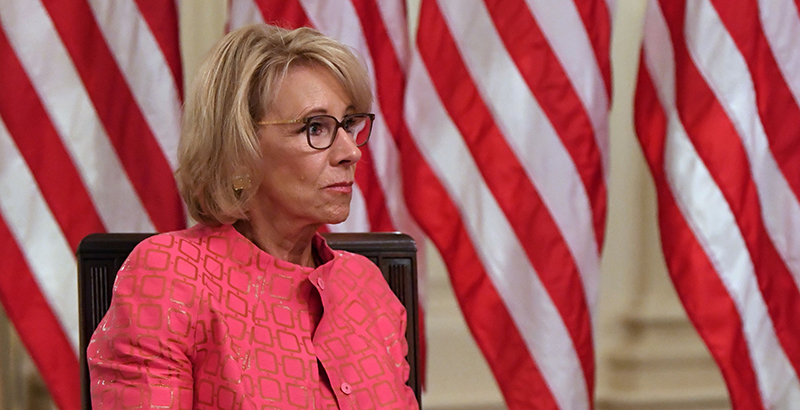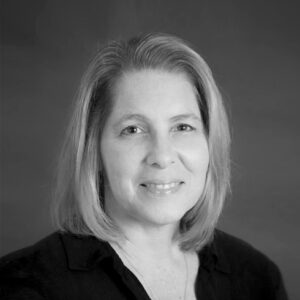Second Federal Judge Blocks DeVos Rule Over Sharing Pandemic Relief Funds WIth Private Schools

Updated August 27
A federal judge for the Northern District of California has ruled in favor of plaintiffs in a multi-state lawsuit that U.S. Secretary of Education Betsy DeVos’s rule for sharing federal relief funds with private schools would cause “irreparable harm” to public schools.
Judge James Donato became the second judge in the more liberal 9th Circuit to decide against DeVos over the rule. Last Friday, U.S. District Judge Barbara J. Rothstein in Washington state ruled similarly.
“An executive agency like the Department has no authority to rewrite Congress’s plain and unambiguous commands under the guise of interpretation,” Donato wrote. “There is also strong public interest in safeguarding our nation’s public schools from the pandemic, and giving school districts access to the funds that Congress authorized for this very purpose.”
Hearings have not yet been held in two additional cases over the same rule, one filed by the NAACP in the District of Columbia and another filed by the Council of Parent Attorneys and Advocates in Maryland.
An attorney representing nine states and four school districts told a federal judge Tuesday that U.S. Secretary of Education Betsy DeVos overstepped her authority when she issued a rule stating how much federal pandemic relief money should flow to private schools.
The hearing, before Judge James Donato, for the Northern District of California, was the latest development in a lawsuit against DeVos over how education funds within the Coronavirus Aid, Relief, and Economic Security, or CARES, Act should be distributed.
“What they have attempted to do is rewrite the statute,” said Neil Giovanatti, assistant attorney general for the state of Michigan, rejecting the department’s argument that students in private schools have been harmed by the pandemic as much as students in public schools. DeVos, he said, “pulled a reverse Robin Hood, taking from the poor and giving to the rich.”
But William Lane, an attorney with the U.S. Department of Justice, said DeVos viewed the language in the law as confusing and decided there was the need for a rule.
“The department decided to make sure students across the board receive equitable funding,” Lane said, adding that any harm public school students have experienced because of the pandemic is “equally applicable to private schools.”
According to U.S. Department of Education data, the poverty rate for the 5.7 million students in private K-12 schools is approximately 9 percent. The poverty rate in public schools is twice as large.
The plaintiff’s request to stop the rule’s implementation is the latest step in what has been a contentious debate since April 30, when the department initially issued guidance with a broader interpretation of how Title I funds for students in low-income families are traditionally distributed to nonpublic schools.
The CARES Act, passed in March, said that funds in the $13.2 Elementary and Secondary School Emergency Relief Fund and the $2.9 billion Governor’s Emergency Education Relief Fund should be distributed “in the same manner” as Title I funds are allocated under existing law.
The department’s guidance said that school districts should set aside funds for students in private schools based on the percentage of students in their districts who attend those schools. But on July 1, the department expanded on that language with a rule that alters the normal formula for how funds should be shared with nonpublic schools.
The rule says that if districts want to use the funds for all of their public schools, they would have to calculate funds for private schools based on the total number of students in their district that attend those schools. If they want to restrict the funds for Title I students, then they would determine funding based on the number of low-income students in their district that attend private schools.
That action prompted the lawsuit involving California, Michigan, Maine, New Mexico, Wisconsin and the District of Columbia. Plaintiffs joining later were Pennsylvania, Wisconsin, Maryland, and school districts in Chicago, Cleveland, New York City and San Francisco.
The rule also required a public comment period. By July 31 more than 13,500 comments were submitted on the proposal — both for and against. Lane said that based on those comments, the secretary would soon be issuing a final rule.
One opponent wrote that the department’s “justification for this misguided approach is based on the false assertion that the pandemic has harmed all our nation’s students by disrupting their education. The harm has not been experienced equally. The data clearly show that communities of color are hit disproportionately hard by COVID-19, the same communities where our nation’s most vulnerable students live and attend school.”
A supporter of the plan wrote: “COVID-19 has devastated all sectors of education, and private schools have not been spared. These schools, many of which are small and lack the resources of larger school districts, are struggling to safely and effectively serve their families as a result of the pandemic.”
A ‘real-world example’
Donato asked for a “real-world example” of how the rule impacts public schools. Giovanatti said if a district restricts the funds to Title I-eligible students, it couldn’t spend the funds to respond to needs related to the coronavirus. The New York City Department of Education, for example, wanted to use the funds for a districtwide remote learning program. Wisconsin wanted to use the funds to disinfect buses, but both poor and nonpoor students ride the buses, he noted.
“These are emergency funds, and we are currently in the emergency,” Giovanatti said, adding that private schools have had access to other CARES funds, such as the Paycheck Protection Program. He also said that providing “equitable services” to private school students, as the law requires, is not the same thing as distributing funds equitably.
But Lane argued that Giovanatti’s example of disinfecting buses is exactly why DeVos issued the rule and that picking and choosing which students receive aid in a crisis is not what Congress intended. He said districts want “unfettered money,” and he countered that public schools receive other taxpayer funds that private schools are not eligible to receive.
Donato asked about the status of another CARES Act-related case in which the state of Washington sued DeVos over the same issue. A hearing for that case, in which the plaintiffs are also asking that the court prevent the rule from being implemented, was held Aug. 10, but no decision has been issued. The Council of Parent Attorneys and Advocates is also suing DeVos in Maryland over the rule.
The judge asked Giovanatti if the plaintiffs would have preferred that DeVos issue the rule earlier, instead of just the guidance. Giovanatti said there was no basis for the rule in the first place.
Donato asked Lane what’s wrong with allocating a larger share of funds for public schools, if that was Congress’s intent. Congress left the law ambiguous, Lane replied. After getting Lane’s agreement that the CARES Act funds are formula grants, he added, “In our circuit, we hold that formula grants are not subject to rulemaking powers,” perhaps offering a hint as to how he is leaning.
DeVos’s rule, Giovanatti said, has left districts under a “looming threat of legal jeopardy,” not knowing if the department will withhold funds in the future if they don’t abide by the rule. Although a June report from the Government Accountability Office showed that just a small fraction of the $13.2 billion had reached the district level, Giovanatti said that a lot of districts were waiting for the outcome of this case before spending the funds.
Lane said that the rule doesn’t give districts the “license to say, ‘Do your own thing.’”
If the rule differs from the statute, Giovanatti responded, “then the statute governs.”
Get stories like these delivered straight to your inbox. Sign up for The 74 Newsletter

;)
